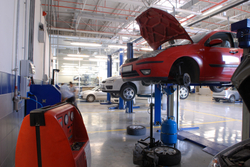b>How important is wheel alignment?
Think of it this way: research indicates that the average vehicle is driven about 12,000 miles per year. A car with a toe angle misadjustment of 0.34 degrees (only 0.17 inches) out of specification will drag tires sideways for more than 68 miles by the end of the year!
What are the symptoms of a vehicle with incorrect alignment?
Have your vehicle checked if you notice:
- Excessive or uneven tire wear.
- The vehicle pulls to the left or right.
- Feeling of looseness or wandering.
- Steering wheel vibration or shimmy.
- The steering wheel is not centered when the vehicle is moving straight ahead.
How often should I have my wheels aligned?
Follow the vehicle manufacturer’s recommendation noted in your owner’s manual. As a general rule, have your wheel alignment checked every 10,000 miles or at least once a year.
The importance of Total Alignment:
- Reduced tire wear: Improper alignment is a major cause of premature tire wear. Over the years, a properly aligned vehicle can add thousands of miles to tire life. Most tires are replaced prematurely due to adverse wear.
- Better gas mileage: Gas mileage increases as rolling resistance decreases. Total Alignment sets all four wheels parallel, which, along with proper inflation, can minimize rolling resistance.
- Improved handling: Does your car pull to one side? Do you constantly have to move the steering wheel to keep your car traveling straight ahead? Many handling problems can be corrected by Total Alignment service. With all the vehicle components aligned properly, road shock is more efficiently absorbed for a smoother ride.
- Safer driving: A suspension system inspection is part of the alignment procedure. This allows worn parts to be detected before they cause costly problems.







